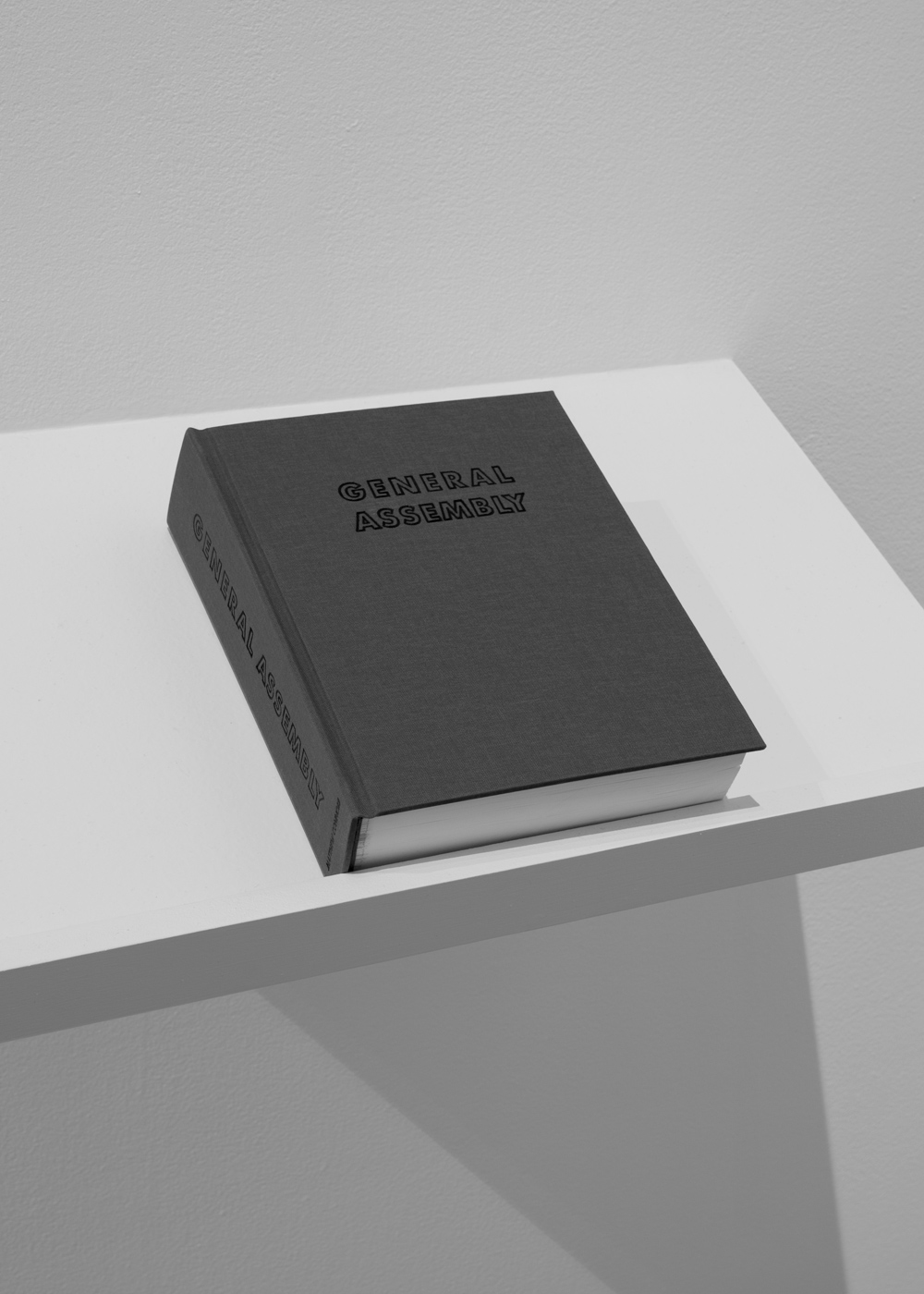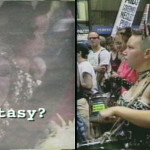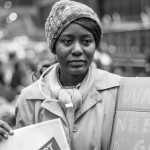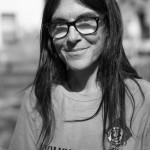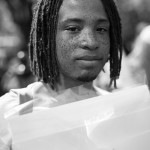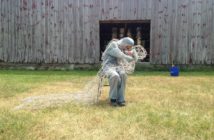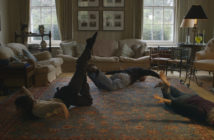"The whole world is watching!" This emblematic chant for accountability, which echoed through streets nationwide for the duration of the Occupy protests, would have been both meaningless and impossible without the technologies we have at hand. Watching, we were: on browsers, iPhones, tablets, cameras and TVs, sympathetically, with hope, with curiosity, and with disbelief too at the impulse of a movement which seemed increasingly unstoppable and felt so overdue. Along the spectrum of responses there were different kinds of skepticism too: there was raillery, and outrage, and disgust, flat out mockery and misrepresentation. Matthew Connors and Dana Moser occupied, the former in New York City, the latter in Boston and elsewhere around the country. While they did, they documented the biggest movement for social change this country, and the world, had seen in many decades.
Their work about Occupy happened to coexist in an exhibition, not because of related subject matter but because Connors and Moser are colleagues at MassArt, and it was in the college gallery that the idea of them sharing their experiences and exchanging thoughts about each other's work and involvement came to my mind. Dana Moser's video (below, and I highly recommend watching it fullscreen with headphones) takes its title from the chant that served as both weapon and shield, much like the millions of cameras, manned and remote, which bore witness daily. It encompasses the energy of that year even as it critiques our weakness for mediated experience. In its patient and methodical accumulation of over 600 gazes, Matthew Connors'General Assembly possesses a quiet conviction and an unflinching presence. Yet folded into this document is a memento mori to the movement. It calls on us to remember efforts too easily forgotten. And it reminds us of their possibility. The conversation that follows expands on both works by revealing the personal commitment these two artists showed not simply to the creative subject but to the causes they advocate.
— Stephanie Cardon
Dana Moser, The Whole World Is Watching the Whole World Watching, 2012. Digital video. 3'10"
Matthew Connors How about we begin by exchanging thoughts on our participation in the Occupy movement and how our involvement fits in the context of prior artwork we were making. I am interested to hear how your video, The Whole World is Watching the Whole World is Watching, relates to other pieces of yours, to your activism, and to the overt political content in some of your earlier work . . . because for me personally, my exposure to the movement was in some ways an awakening. The book, General Assembly, and the way I took those portraits are outside the lineage of how I'd been working until then. Is The Whole World is Watching . . . on a pretty seamless continuum with your earlier work?
Dana Moser I've always thought of my artistic contributions as something that participates in the struggles I'm a part of, an approach which sometimes gives the work a short shelf-life. In addition to being a filmmaker I'm a musician, and I make sculptures, kinetic works and programming for interactive installations. For a while I was doing live performances for the stage using sampled sounds. I made a number of works about queer politics around the time Ellen Degeneres came out on her TV show using sound samples from the show, quotes of her talking about her desire just to have a white picket fence, and lead a normal life—the hetero-normative aspirations of someone from white privilege wanting to be able to come out. I guess I was offering a critique of that moment in pop culture and what it really had to do with liberation for queer people. Someone today might not recognize those soundbites, but at the time, for people who were involved in gay and lesbian liberation struggles, it was a big deal to have a national personality come out on TV, and those people would certainly recognize the quotes. I think The Whole World is Watching . . . may be bigger than the current moment, or than the moment in which most of its footage was shot, while still reflecting a very particular moment in time.
You say General Assembly was a diversion, or a different way of approaching photography. How would you characterize your approach previous to this project?
 Dana Moser
Dana MoserTourism (installation view) 2005
An interactive installation with imagery from Afghanistan and Iraq.
MC Well, my process prior to this was very different. The pictures I was making had different considerations. I’ve had a longstanding interest in the ways people choose to represent themselves in the public sphere, but in earlier images I was thinking about the specific visual history of street photography, and our shifting relationship to the medium during its current technological transformation. Those images—which I later titled Tenuous Republic—were seamless, digital collages of photographs I was taking on the street. They gave the illusion that they were a singular moment but were in fact an assemblage of fragments of time. Through this process photography became more malleable and allowed me to tamper with the notion of the decisive moment, which had been sacred to generations of street photographers. The resulting pictures depicted fictional interactions that I wanted to have the veracity of a witnessed moment as opposed to the overt theatricality of some staged photographs. Everyone I photographed was an anonymous stranger I didn’t interact with, and the pictures—taken all over the world—were framed so as to not convey a sense of a specific place, but rather a generic, post-industrial city.
DM How long had you been doing that work?
MC About seven years. When the Occupy movement started there wasn't precise moment when I decided to make a project out of it. I just went down to Zuccotti and I started making portraits. I quickly got wrapped up in the events on the ground. It was a far more relational way of working for me. I saw the photographs as a way of interacting with people more than anything because, after the movement got up a little steam and a fair amount of media attention, there was a sense of it being this continuous tourist experience. People would go down to Ground Zero, they would go shopping at Century 21, and then swing by Zuccotti Park to almost aggressively take pictures, not interacting with anyone. I saw the ways in which photography was being used to distance people from the movement and make them spectators. I made a rule that I would go and actually engage with all the people I took portraits of, talk to them about their involvement, get their contact information, email them the pictures, and I would return to the Park with printed photographs that I would hand out. It became an exchange of images and ideas. This crystallized a social landscape I saw emerging there. I was excited by that more so than by the pictures themselves. The pictures were a vehicle for a kind of interaction I felt I had not had growing up on the outskirts of New York City. And I felt that New York had lost this sense of an emboldened activist community a long time ago. Over time the pictures started to mean something different. After I had amassed several hundred, it became a portrait of the movement.
DM Your series of portraits wasn't relying on any digital manipulation after the fact. It seems like you could've been shooting film and printing them as silver prints, or is that not the case?
MC That would have been possible, but not practical. I think the sheer volume of pictures I was taking was really enabled by the use of a digital camera, both economically and logistically—I made over 15,000 pictures, not 15,000 portraits of course, I would take multiple pictures of each person. Doing them in film would've been prohibitive and this way I could turn everything around the next day. I got into a rhythm of taking pictures, going to the studio that night to make prints and showing up with them the next day because that gave me the best chance of catching someone who might be there on successive days. The digital technology enabled that in a way that would not have been possible with analog means. I don't think this work has anything to do with the malleability of digital technologies but more with the ease of production.
DM You called General Assembly a portrait of the movement but I'm wondering, if all the signs that made reference to the Occupy movement were stripped away, whether you would just see it as a series of portraits. Are there qualities to them that you can identify as signifiers of that particular moment in time?
MC No. I don't think so. And the signs are really fragmentary. That was a decision I made early on. I did see other people making portraits in a way that revealed the complete message of the sign. I made the decision to show only bits and pieces of them, because I wanted the attention to be on the people. Some indication that they were protesting remained but I avoided the complete message because I didn't want someone approaching the picture to be reading the sign and judging the subject based on what it said. I wanted them to be confronted with the fact that this accumulation of people was at this place and time struggling against existing structures of power. I've exhibited the work in several different ways, one which was a sequential projection of images, and one which was a grid of over 600 of them. In the grid something happened that I really liked, the signs counteracted the tyranny of the grid, because they would blend into one another. There was something visual and graphic about it that I felt was important to taking in the breadth of everything as a whole.
DM It's something that I find haunting about the work actually. It's almost the flip-side of Hannah Arendt's observation about the banality of evil: here we have a banality of goodness. Since the work announces itself as the portrait of all the people who were part of this optimistic social movement, I'm trying to look in their faces for how I could recognize them as being such. And I find that there's a person there who looks really happy, and there's another one that has a look of grim determination, like they've been struggling for social change for 20 years and they're still hunkered down in the bunker. I keep looking at those faces wanting them to cohere into the spirit of social change's indomitability. And I keep thinking, well that person just looks tickled pink to have their picture taken. And that person . . .
MC I think you're asking a portrait to do too much then, because all of what you describe is a fiction. I was very conscious of the ways people were trying to project something. You could see that some just couldn't relax out of that: they wanted to be this stalwart, inspiring figure that was …
DM . . . a social realist painting looking heavenward.
MC Yes. There are other versions of each of these pictures where people look like they've come out of a North Korean propaganda poster. I didn't want that. What you're asking, that kind of legibility, for me doesn't exist in this kind of portrait. For me photography fails in that way. It can allude to things but there's no way it can capture an internal psychological state. It can dramatize but it can never really tell the truth in that way, because whatever you read is your own projection on the image.
DM How many strangers did you find after the fact to gift them their portraits?
MC Less than I wanted to. About 100 or so. I made a clunky book of thumbnails of all the pictures, under which I'd write people's names. For a while, I was on a first name basis with several hundred people in the movement ... on a good memory day. I had a very horizontal engagement in the movement, which was probably different from yours, and I'm curious to hear about your experience. A lot of my friends were more deeply involved in specific working groups. I felt a little bit more chameleon: I could shift around and get a sense of the breadth of what was going on, but I felt as though I wasn't as deeply engaged in certain issues as others were.
DM It may have been a structural flaw, but one of the powerful parts of this particular movement was how porous its edges were. There were definitely people who were engaged in a sympathetic way. You could count them as participants in the movement for social change, their sympathies were there, their energies were there, but they weren't showing up in the morning to bail out the flooded tents. I feel like you were a documentarian who was not neutral, an advocate for the process of social change, but you weren't one of the people bailing out the tents in the morning. Am I wrong about that?
MC You're mostly right, but there were slippages between the two, and my engagement changed over time. I spent a couple of nights in jail because I got arrested at a direct action in which I decided to participate and not photograph. I attended a lot of working group meetings, partly to build trust with people and partly because I became interested when things really began shifting. I started to gravitate, mainly after the eviction, to the groups that were working in the area of debt resistance, largely because I read David Graeber's book. I met him at a teach-in and, early on, I began working with people from Strike Debt. Those are the people that I got arrested with and with whom I was participating in direct actions. As I saw frictions develop in the movement, and as it started to break down, those are the people I felt were still doing really positive work.
DM Before the eviction, which working groups were you a part of? Did you do stuff with Media?
MC No, I did some stuff with Arts and Labor, and I was somewhat of an honorary member of the Disability Caucus because I really found those people to be the most amazing. They were a constant presence in the Park, and because it was such a chore for them to get there, I knew I could go at a certain time and find them. I think I developed stronger relationships with some of them as a result. I went to Spokes Council a few times, but that was completely dysfunctional. And I participated in a bunch of General Assemblies, which was something that inspired me. I think it was somewhat of a flawed process but one that is worth revisiting. My book mimics some of the ambitions of the Assembly's radical inclusivity. But I think you're right, there was a hierarchy in the way people engaged with the movement, and I tried not to make those distinctions. David Graeber's portrait is in the book alongside pictures of people who showed up for two hours and that was the extent of their participation. The pictures in the book are sequenced roughly chronologically. It starts in September 2011 goes to September 2012, and it's exactly one year.
DM I wasn't saying that there was a hierarchy, I was saying that the edges were porous. Also I think that people's relationship to photographing was complicated. Part of what I'm documenting in my video is the aggressive way people were behaving, in the tourist way you were describing, as though they were taking pictures of the Grand Canyon. It got to a point where participants would wear signs saying "I'm not an animal in the zoo" because people were treating the Occupy movement as such. But I also observed people in Boston who were teachers: they came down to Dewey Square with their children because they thought they were witnessing an historical moment, that they had not seen in maybe 40 years, of uprising and revolution in this country and they wanted their children to see it. I can't tell you how many times I saw this happen: people were bringing their kids and the cops would tell people that it was an incredibly dangerous place with drugs and violent crime and terrorism, but people kept coming. That was a kind of documentation attitude I guess, more than being a tourist, and they were sympathetic to whatever kind of cause they thought was going on, yet it was also on a continuum with people who came to photograph what they saw as a freak-show.
MC That's definitely present in your video, but there's something else there that speaks really effectively to the new accountability which has emerged from a shifting media landscape. The movement really capitalized on live streaming, every moment was documented, and over time that changed the way the people and the police would react to things. This was part of my motivation as well because I thought there was an over-simplified media narrative which often aimed to discredit what was going on. It motivated me to show that these protesters were not an irrational force.
DM I thought about that a lot during those days. I went to visit a number of Occupy encampments around the country, and I was struck by the fact that at the one in Oakland, which was one of the most active and dynamic ones in the country, they renamed the occupied plaza Oscar Grant Square, after the African-American man who was shot on a subway platform by police. This sparked a meditation on a different historical moment when in '91 Rodney King was beaten up. At that time it was just by chance that someone happened to be on their back porch with a video camera. In general, people didn't have videocameras out in their hands walking down the street. But the night Oscar Grant got killed in 2009 everybody had a videocamera in their pocket. The way in which historical moments can be recorded has been forever changed.
I had been on sabbatical the semester that the Occupy movement broke out. In fact, that autumn I had been so demoralized by the increasing convolutions and twists to the Right in this country, that I was thinking about moving to Berlin, and had spent a month there actively investigating the possibility when the movement started. When I got back, I went straight from the airport to Dewey Square to see what was happening. Right away I gravitated to the creativity at work in the construction of the camps. They were these crazy hybrids that had different levels of technological infrastructure, in most cases just by accident of their neighborhood. Because it was in Boston, the Occupy Boston camp immediately put bicycle-powered generators in place in a tent. Every day I would go to the camp and do maintenance work on the generators or deal with electrical infrastructure. That was a great way to meet people that I never would have met who were electrical engineers at the same time as they actively engaged in political struggles. We developed some technologies, that we basically invented, to support the infrastructure of the camp. We did lighting for the Food Tent and the Medical Tent and the Media Tent. This daily interaction with infrastructure in some ways was a diversion. The energy that went into maintaining the camps was something one could write volumes about, because it exposed the horrific shortcomings of the richest country in the world's support for homeless people and for people who are starving. The camps became magnets for people who are street people. We know that both in New York and in Boston, police were engaged in trying to sabotage the camps by directing people who were unstable, violent, strung out, desperate . . . saying "Go. Get a warm meal there." I'm sure you witnessed this response over and over in New York, like we did in Boston: people didn't want to reenact the heartless motivations of capitalism by letting those in need fall off the bottom rung of the ladder, and wanted to demonstrate a kind of mutual aid, to borrow a phrase from Kropotkin, and find a way to give them some material support. But that's something a full-time relief agency could spend all of its time and millions of dollars on, and here it was done with no resources, in a voluntaristic way which wound up burning people out at an amazing rate. People came upon their limits humanly when they were dealing with the distresses of maintaining those camps. It was sort of like a tactic that didn't have a unified goal. The fact that some people in the movement were for reform and were interested in getting Barack Obama reelected, and others wanted revolution and had no interest in electoral politics, made it this amazing, beautiful laboratory where people first-hand were processing the different experiments around hundred-year old debates on the Left, within the span of a few months.
MC I think that's exactly right, although I can't pretend to be any sort of historian of what happened. But what I witnessed was very similar. Most of it came to a head after the eviction. Especially in Zuccotti Park, where people had come from all parts of the country with no real resources, no place to live, they found themselves in the most expensive city in the country without a home. Complicating this was the fact of the movement was sitting on a pile of about one million dollars not knowing what to do with it. Most of the friction in the General Assemblies started to come from discussions about what to do with the money because, as you articulated, a lot of people wanted it to be a mutual aid movement and others wanted it to be solely a protest movement. Those opinions started to collide pretty aggressively. I think one of the difficulties of the General Assembly was that they allowed anyone to block any proposal. It turned into Congress: everything shut down because anything could be filibustered.
DM Right, so the ability to organize together from such a heterogenous set of goals and perspectives broke down, but I don't think everything broke down, as we witnessed with the Sandy relief program. People nationwide are acknowledging that that's an example of how to think about the movement post-encampment. The network of affiliations and radicalization is intact, it's just that the people who couldn't stand being together for a meeting stopped being in the same room.
MC Yeah, they just went to different parts of the Rockaways. And that was an amazing thing to witness. We spent about a week running food to upper floors of buildings with no electrical service, to help elderly people.
DM And FEMA and the Red Cross had no clue how to support those communities, but the group that had been Occupy Wall Street swung into action because they knew each other, had huge distribution networks and knew all the personalities and people who would be in each neighborhood.
MC And that was all facilitated by a technology infrastructure that didn't exist ten years ago.
DM One of the things that I appreciated in looking at the range of the portraits in your series is the intergenerational make-up. Some of us who were involved in information technology support for the Boston area are now teaching workshops in free software at the South End Technology Centre maintained by Mel King. He's about 90 years old at this point and a great progenitor for political activism in the City of Boston. We had a very moving conversation with him yesterday: he gave us a kind of pep talk. I'm not sure why he felt that was necessary, but he wanted to make a point of sharing how important it is that we not feel demoralized and not doubt for a moment that our work had been significant and important, and by us he meant the nationwide Occupy movement. He was thanking us for that work, yet we gave the gratitude right back to him because he's one of the people who laid the foundations for doing creative critical actions that could dislodge entrenched mechanisms which facilitate racism and classism in Boston. There were people like Noam Chomsky, who were philosophical and spiritual antecedents, and then you can go back to whatever philosophical leaders you could point to, but even though the corporate media will be quick to pronounce those people and those movements and those ideas dead, when they drop out of the public eye, they never have died at all, but have been contributing to the ongoing evolution of radical activity in the United States. Looking through your photographs you see the different generations of the people who were all present. People who just woke up yesterday to the idea of inequality around the country, and people who've been working on it for 40 years.
MC I learned a tremendous amount from people who are younger than me. Being open to their ideas was, I think, very important for everyone in the Movement. And then some of my favorite people to talk to were the old women who would sit in lawn chairs and knit hats for the occupiers. That was their contribution. They would just sit on the front lines and knit.
Was Chomsky in Dewey Square at all?
DM Yeah, he came and gave a major address to the assembled group that you can find online, transcribed. It was at the peak of the heady days when the Occupy movement was spreading rapidly. People were noticing that it had gone to every major municipality around the country and that, for the first time in decades, people were making connections with what was going on internationally as well, in Tunisia and Egypt and against dictatorships around the world. The phenomenon of protesters in Tahrir Square buying pizza for those in Zuccotti Park was an amazing moment, and it was around then that Chomsky came and spoke. People thought he was going to talk about the historical grand changes that were imminent. He was much more modest in what he was willing to acknowledge was going on: he said that the most important thing that had happened was that we'd met each other. He said that if people remained connected to one another and built solidarity between different groups, then a mass movement would be possible. I appreciated that observation on his part because I feel like he's been through so many struggles in his life he has a sense of perspective.
MC I brought some of the portraits to Tahrir Square and in a lot of ways they shifted people's attitudes towards me. I was there during some tense months.
DM You were there during the nasty downturn from the exhilaration of the revolution. What did they think of the portraits?
MC They were most interested in the ones I was taking in Cairo, which I was also bringing back to Tahrir. But I would tell them the influence that the Egyptian Revolution had on America, and it was exhilarating for them to feel like what they were doing there had reverberations around the world, especially in a place like America, and that we were inspired by them. That really lifted their spirits. It's a very complicated time in Egypt right now. I got there after the downturn but the ground was, and still is shifting very quickly. Now that the army's back in power I think a lot of the original January 25th activists are feeling fairly despondent about the future.
DM It's been interesting to hear the response that people had to the video I made, because watching it they remember the emotions of that moment in time. And it's incredible how fast we can forget highs and lows. Evolutionary biology has helped equip us with that quick loss of memory so that we don't fixate on painful or disappointing things.
MC I agree. I think the video's really effective for that, and the soundscape of it is amazing. The visceral, pulsating rhythm brings you right back into a direct action in ways that I think the pictures I made don't: they're more abstracted, they're silent, black-and-white, they don't give as much context. They were meant to do that, but your video makes the moment palpable.
DM The soundtrack is largely taken from the night the judge lifted the restraining order from the Boston Police and said that it was okay for them to evict the camp. That day the police passed out notices around the camp announcing that anyone hanging around Dewey Square after 9 o'clock that evening was subject to arrest, which made it the most illegal place to be in Boston. That was the night that around 3000 people showed up with marching bands and drums, and were dancing in the streets until 3 or 4 o'clock in the morning. There were people after the fact who said it was the most exhilarating moment in their lives. And there's a teeny bit of that energy in the soundtrack still. I don't think an experience like that is easily forgotten, no matter how fast the corporate media pronounced the entire activity a folly that's now over.

Dana Moser, When is a Political Movement Like a Sexual Fantasy? 1997. Video still.
MC What is your sense of where things will go now in Boston?
DM I think it's similar to what you experienced in New York. Many people who had not encountered the work already in place for people with disabilities and homelessness are now either supporting that work or actively putting energy into it. In Boston there's City Life Vida Urbana which has been doing tenant activist work, helping people understand the criminality of the banks. Hundreds of people came to understand that as a result of the Occupy movement . . .
The burnout was intense. The encampments gave people an easy way to engage and make their participation visible, which is I think why the state wanted to destroy the encampments. I'm not sure how to monitor the newly activated population that now has been made invisible. Hurricane Sandy made Occupy Sandy a necessary activity making that whole network of affiliated humans visible once more. So I suppose if some similar catastrophe happened in Boston it would be revived too, just as we would see it revive in Austin or Portland or Oakland or Chicago.
MC Before Hurricane Sandy even happened Rebecca Solnit was writing about the Occupy movement as a movement of disaster recovery—it was economic disaster recovery. So that's why the infrastructure was so easily mapped onto the recovery effort for the hurricane. I think my experiences are similar to yours. I've been following the activities of the Strike Debt movement and what was going on at Cooper Union to some degree, partially because of where you and I teach and because of an interest in our students' future and how debt will impact them. I take heart in what Strike Debt are doing because I see real tangible progress in the Debt Resistors' Operations Manual [PDF download] they've authored which is now going to be published. They announced last month that they've already forgiven over $15 million of medical debt in communities in upstate New York. So there are real ways in which they are changing people's lives.
DM There's a more disruptive contribution that's been made, in my opinion. The traditional Left, whether it's what people think of as a progressive wing of the Democratic Party, or various socialist parties, or Marxist, or Communist, were always very hierarchical. The degree to which this spontaneous uprising around the country had an inspiration that came from a nonhierarchical place, with anarchist antecedents, seems to me very unusual and very pregnant with creative possibilities, because of its radical democracy. People were able to participate from all different levels of experience. This was amazing. It was disorienting, I think, to a lot of traditional leftists, and really inspiring to a lot of young people who had been turned off by traditional leftists. It seemed to present a creative space for people to imagine something different, and we don't even know yet what people will come up with in that place.
- General Assembly Photographs and text by Matthew Connors 665 pages Inkjet prints Hardcover, bound by hand, 7.75 x 9.75 inches
- Dana Moser When is a political movement like a sexual fantasy? 1997 An experimental video documentary featuring pioneering gay and transgender activist, Sylvia Rivera
- Matthew Connors Bernie, 2011
- Matthew Connors Nan, 2011
- Matthew Connors Jes, 2011
- Matthew Connors Joan, 2012
- Matthew Connors David, 2012
- Matthew Connors Quade, 2012
- Dana Moser Tourism (installation view) 2005 An interactive installation with imagery from Afghanistan and Iraq.
This conversation took place on December 4, 2013.
Dana Moser's The Whole World is Watching the Whole World is Watching and Matthew Connors' General Assembly were included in the exhibition "Selections" at Massachusetts College of Art and Design's Paine Gallery, September 30 to December 7, 2013.
www.massart.edu

